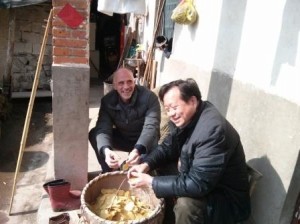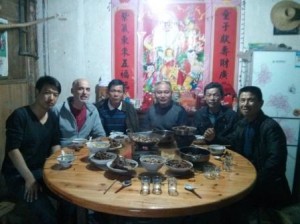Oral History: New Year Down On The Farm

This year I decided to formally end my 23-year-old informal ban on trips to the countryside during the Spring Festival holiday, and went to visit friends in 2 small Anhui towns to see what’s changed over all that time. What I found was an interesting hodgepodge of the old and the new, with many traditions still alive and well even as some get nudged out by encroaching modernization.
The last time I made such a trip was in 1991 when I was living in Hong Kong and spent the holiday with the family of a friend from Zhongshan, a small city near Macau. That trip was most memorable for its nonstop eating, starting with the traditional New Year’s Eve dinner and then extending for the next few days as we were stuffed continuously during numerous bainian trips to visit friends and relatives. I didn’t consciously decide to halt more New Year’s trips after that, but rather just avoided them not only for the overeating but also all the other inconveniences that come with peak period travel.

All these years later, eating was still a central part of my visits first to the town of Shucheng near Hefei, and then to an even smaller town called Jingxian near the scenic Huangshan area. But what most caught my attention wasn’t the food in people’s homes, but rather the large number of restaurants and other shops that remained open throughout the holiday.
In previous times, even major cities like Shanghai used to shut down completely for the Lunar New Year, and it was nearly impossible to find anything open for at least the first 4 or 5 days of the holiday. That certainly wasn’t the case in either Shucheng or Jingxian, where many shops and restaurants were open nonstop throughout the festival. It seems the attraction of a few extra dollars is stronger these days than centuries of tradition.
While many shops were open throughout the holiday, one thing that hasn’t changed much was the complete lack of environmental awareness in these smaller places. Environmental protection and conservation may be hot topics in big cities like Shanghai and Beijing, but the concepts have yet to be discovered in these smaller towns.
My friend from Shucheng proudly informed me before my arrival that his hometown had just opened its first KFC, a big achievement for a town of that size. Following that big opening late last year, people were lined up outside at all hours to get a taste of the chain’s greasy fried chicken, he informed me, reminiscent of the opening of China’s first KFC in Beijing in 1987.
We passed by the store a few times during my visit, and it was always crowded but not quite as full as my friend described. I wasn’t surprised to see it was open throughout the holiday, but was somewhat startled to discover that this particular KFC was one of the grungiest I’d ever seen. The floor throughout the restaurant was streaked with mud, creating a general feeling of dirtiness.
That grungy theme was repeated throughout the downtown Shucheng area, where the streets were strewn with all kinds of trash tossed carelessly by people who treated the area as their personal garbage can. I’ve written about this phenomenon before, calling it the “world is my garbage can” mentality. But I didn’t realize how much more serious the problem is in smaller towns than in big cities like Shanghai, where many people are more likely to throw their garbage in a trash can.
Similarly, awareness of air pollution was nonexistent in both of these places, especially on New Year’s Eve in Shucheng, where the fury of exploding firecrackers created a smoke so thick that it lasted well into the next day. I’m sure the PM 2.5 index, which is closely watched in most big cities these days, exploded to the 1,000 level or higher at its peak in Shucheng. But then again, I doubt anyone in these towns has ever heard of PM 2.5, and I’d be equally surprised if the towns had any air quality monitoring equipment at all.
Transport was another area where huge changes were obvious, mostly in the form of abundant highways and modern roads that made travel much easier than in the 1980s and 90s. I got to take several scary trips on those roads, including one where my friend’s brother-in-law drove like the maniacs you sometimes see passing everyone on the highways, even though most of us have never actually driven with one.
But despite the huge advances in roads, getting timetables and other information for the buses that form the backbone of transport networks for these smaller towns was nearly impossible. We tried using the Internet to find bus schedules for my trips between cities, but quickly discovered it was a lost cause. Different websites contained conflicting information, and all of it was wrong anyhow. In the end, it seems, the only way to get such information is to go to the actual bus stations themselves, even though such information is easily available online in big cities like Shanghai.
On the whole, I didn’t regret my decision to finally lift my Lunar New Year travel ban after 23 years, and quite enjoyed the festive mix of family gatherings, crowded mahjong parlors, sightseeing and visits to farming villages to burn fake paper money for the ancestors. I do wonder how long it will be before these places realize how badly they’re damaging their environment, and hope that a more modern mindset will also creep in for things like managing bus schedules and hotel reservations.
But at the end of the day, preservation of the festive mindset and the many customs during the Lunar New Year is what’s really important during the holiday season. It seems that element of the holiday is still alive and well in the Anhui towns of Shucheng and Jingxian, and throughout similar small towns throughout China.
